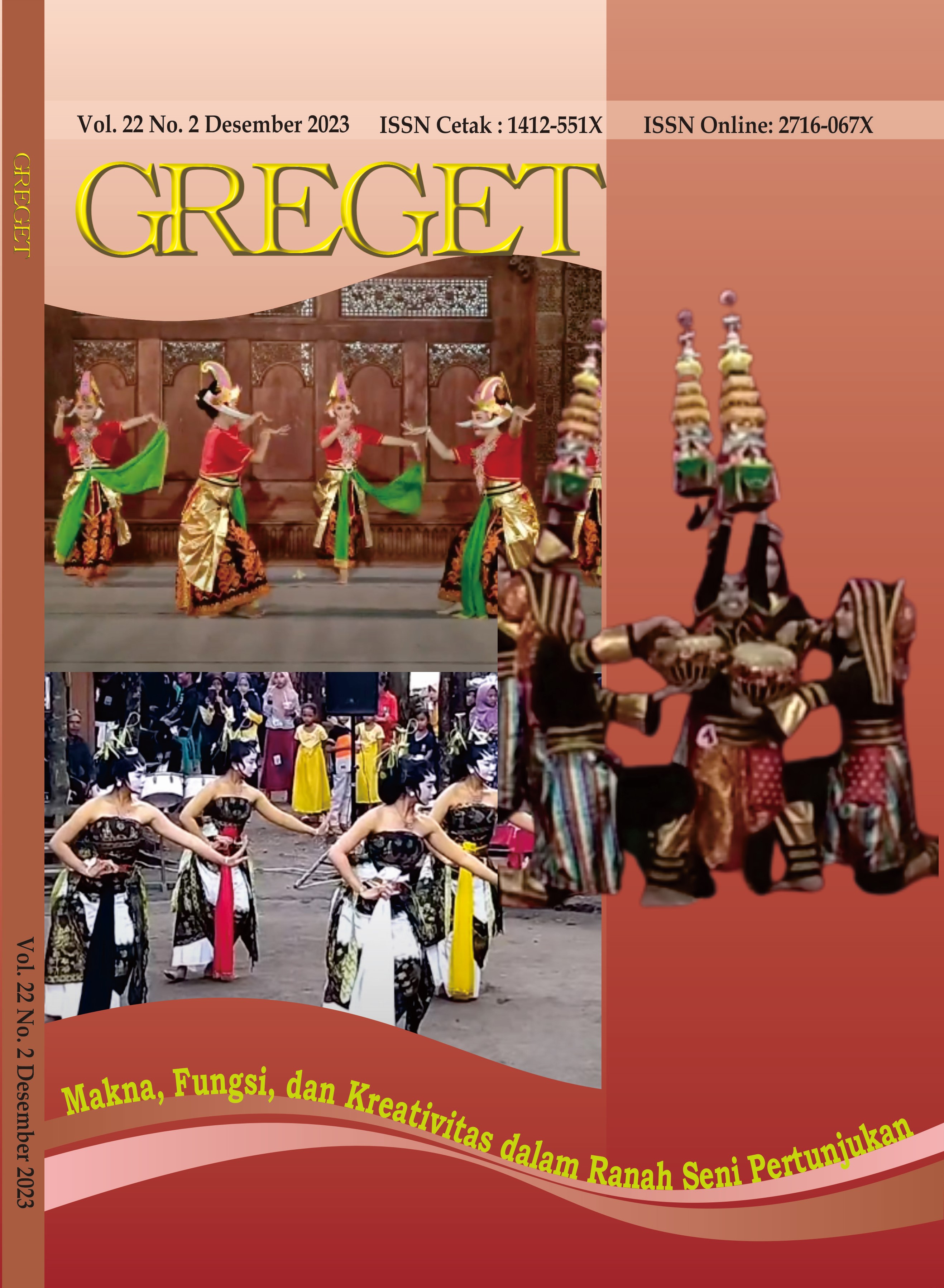BENTUK DAN FUNGSI DRAMA TARI GANDRUNG TERAKOTA DI KABUPATEN BANYUWANGI
Main Article Content
Abstract
One form of the existence of performing arts in Banyuwangi Regency is the Gandrung dance. In its development, various Gandrung dances emerged with various performances. The Gandrung Terrakota dance drama is one of the performing arts that is developing in Banyuwangi Regency. This performance combines drama and dance performances which are performed in groups using a story line with the theme of the history of the journey of a Gandrung dancer. The Gandrung Terrakota dance drama performance form in Banyuwangi Regency was created in 2018 by Mr. Slamet Dihardjo, as a teacher from SMK Negeri 1 Banyuwangi, Dance Department. He, together with the students of SMK Negeri 1 Banyuwangi, Department of Dance, created a work that depicts the journey of a Gandrung dancer to the graduation ritual process of a Gandrung dancer and is ready to perform in full. This study aims to describe the formulation of the problems related to the Gandrung Terakota Dance drama, including: (1) how is the form of the Gandrung Terakota Dance drama; and (2) how is the function of the Gandrung Terakota Dance drama. Both of these problems use qualitative research methods that examine textual and contextual performing arts. There are two stages that must be carried out in qualitative research, namely the data collection stage which consists of observation, interviews and research. The second stage is the data processing stage which is carried out by analyzing the data according to the Gandrung Terakota Dance drama. The research results show that the Gandrung Terakota Dance drama is a form of performance which has 5 scenes packaged into the Gandrung Terakota Dance drama performance. The function of this drama is classified as a function of ritual, entertainment, and spectacle.
Downloads
Article Details

This work is licensed under a Creative Commons Attribution-ShareAlike 4.0 International License.
Copyright
Authors who publish with GREGET agrees to the following terms:
- Authors retain copyright and grant the journal right of first publication with the work simultaneously licensed under a Creative Commons Attribution-ShareAlike 4.0 (CC BY-SA 4.0) that allows others to share the work with an acknowledgment of the work's authorship and initial publication in this journal.
- Authors are able to enter into separate, additional contractual arrangements for the non-exclusive distribution of the journal's published version of the work (e.g., post it to an institutional repository or publish it in a book), with an acknowledgment of its initial publication in this journal.
- Authors are permitted and encouraged to post their work online (e.g., in institutional repositories or on their website) prior to and during the submission process, as it can lead to productive exchanges, as well as earlier and greater citation of published work.
References
Alfian, ed. (1985). Persepsi Manusia tentang Kebudayaan. Gramedia.
Badar, M. Z. (2020). Pemikiran Sejarah Kuntowijoyo dalam Kajian Filsafat Sejarah. Tesis Universitas Islam Negeri Sunan Kalijaga.
Bintoro, Y. P., dkk. (2022). Taman Patung Terakota Penari Gandrung di Banyuwangi Jawa Timur. Jurnal Pendidikan Seni Rupa Undiksha, 12(3), 220-233.
Djelantik, A. A. M. (2001). Estetika: Sebuah Pengantar. Masyarakat Seni Pertunjukan Indonesia.
Fanani, A. (2022). Sendratari Meras Gandrung Banyuwangi Kembali Digelar Tiap Pekan. detikJatim, 29 Agustus 2022.
Hadi, Y. S. (2003). Aspek – Aspek Dasar Koreografi Kelompok. Elkaphi.
Hadi, Y. S. (2005). Sosiologi Tari. Pustaka.
Kholis, A., dkk. (2021). Tradisi Meras Gandrung Banyuwangi. Ejournal Unesa (Kajian Folklor), 17(1), 349-367.
Maryono. (2012). Analisa Tari. ISI Press.
Nugraheni., dkk. (2013). Pengetahuan Tari. P3AI Universitas Lambung Mangkurat Banjarmasin.
Nurhajarini, D. R. (2018). Temu: Maestro Gandrung dari Desa Kemiren Banyuwangi. Jurnal Patrawidya, 16(4).
Prakosa, R. D. (2008). Seni Pertunjukan Etnik Jawa. Gantar Gumelar.
Sedyawati, E. (1981). Pertumbuhan Seni Pertunjukan. Sinar Harapan.
Sedyawati, E. (1991). Seni Dalam Masyarakat Indonesia. ASTI Yogyakarta.
Setianto, E. B. (2017). Analisa Kebijakan Bupati dalam Pelestarian Seni dan Budaya untuk Menunjang Pariwisata Banyuwangi. Dinas Kebudayaan Pariwisata Kabupaten Banyuwangi.
Slamet. (2017). Metodologi Penelitihan Kajian Seni Budaya dan Ilmu Sosial Humaniora. Citra Sain.
Soedarsono, R. M. (1978). Pengantar Pengetahuan dan Komposisi Tari. ASTI Yogyakarta.
Soedarsono, R. M. (1978). Jawa dan Bali Dua Pusat Perkembangan Drama tari Tradisional Indonesia. Gajah Mada University Press.
Soedarsono, R. M. (1988). Seni Pertunjukan Indonesia di Era Globalisasi. Direktorat Jenderal Pendidikan Tinggi Departemen Pendidikan dan Kebudayaan.
Soedarsono, R. M. (1999). Metode Penelitihan Seni Pertunjukan dan Seni Rupa. MSPI.
Soekanto, A. (2019). Meras Gandrung Hiburan Magis di Kaki Gunung Ijen Banyuwangi. astinsoekanto, 27 Agustus 2019.
Subari, L., dkk. (2020). Komunitas Kesenian dalam Membentuk Kepenarian Melalui Ritual Meras Gandrung di Era Tatanan New Normal. Prosiding SNasPPM V Universitas PGRI Ronggolawe, 5(1), 185-192.
Subari, L., dkk. (2020). Peran Ritual Meras Gandrung di Banyuwangi dalam Membentuk Kualitas Kepenarian. Jurnal Satwika: Kajian Ilmu Budaya dan Perubahan Sosial, 4(2), 106-115.
Suci, C. W., dkk. (2021). Pengaruh Penerapan Konsep Pariwisata Berkelanjutan Terhadap Kepuasan Wisatawan Nusantara di Taman Gandrung Terakota Banyuwangi. Jurnal Pariwisata: Sadar Wisata, 4(2), 43-50.
Suharji. (2017). Sosiologi Seni Pengantar Secara Sistematik. ISI Press.
Sumaryanto, T. (2007). Pendekatan Kuantitatif dan Kualitatif dalam Penelitihan Pendidikan Seni. UNNES Press.
Qomari, Y. M. (2022). Meras Gandrung ‘Ritual Sinden Banyuwangi. 14kompasiana, 6 Juni 2022.
Triyono, J. (2022). Penyelenggaraan Festival Gandrung Sewu dan Pengelolaan Taman Gandrung Terakota Banyuwangi Sebagai Wisata Unggulan. Jurnal Sosial Ekonomi dan Humaniora, 8(4), 557-564.
